My Grandparent’s Thul Basket: Basketry and Craftsmanship
By Mrs. Joan Lalromawi
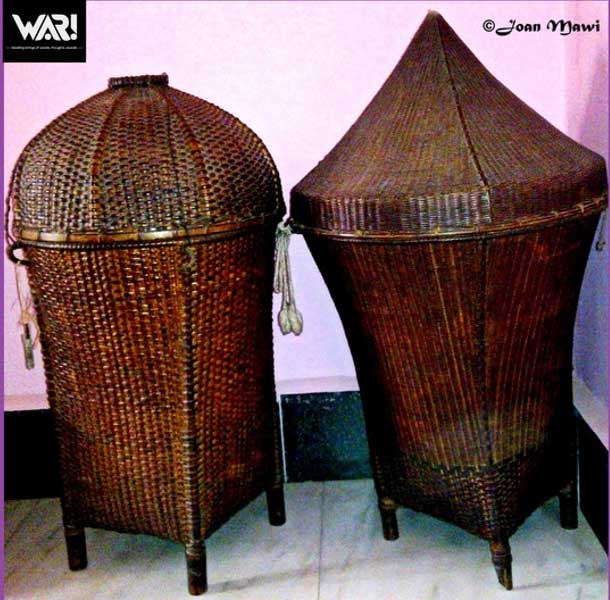
The pictures above are traditional thul (baskets) made of bamboo and cane. They are the traditional craft artefacts of the Paite/Chin-Kuki-Mizo-Zomi tribes of Mizoram and Manipur. ‘Thul’ is a Mizo and Dapzar Paite word meaning storage basket. These baskets have a double-walled structure and four short legs located at the corners of their square base. A lid shaped either like a semi-spherical dome or pointed ends cover the mouth of the basket. There are different designs and the raw materials used differ from people to people. The same storage baskets were called by the Paite tribes in Manipur as ‘lelpi’ or ‘lel luzum’ or ‘guanang’ for the pointed covers as it was made from bamboo and the round covers were called ‘chiinglel’ as it was made from cane.
The baskets in the picture belonged to my grandparents. It was used to store their precious items and other things. We associate the one with a round or dome shaped cover to a woman's storage box as it belongs to my grandma and the pointed cover to a man's storage box since it was grandpa’s. Both the baskets would be kept side by side in their rooms.
As a young child, I remember how precious the round cover basket was especially to my grandma. She had been gifted by her father - my great grandfather - when she got married as part of her trousseau. During those days, it must have been a treasured possession for a girl that by the time she could weave her own puans (traditional loin cloth) which is right after adolescence, she would keep them in this kind of basket (the round headed one) and would store them to take it to the home of her husband once she gets married. Grandma used to close it tightly so that children like us will not open it unnecessarily and grandfather would keep it secure with lock and key.
I can still recall how as children we would be curious and peep through the small openings when grandma opens it up and want to see what all treasures could be there. Though we were forbidden to touch them unnecessarily, we would at times go to their rooms and slide our hands on the outer cover of the basket and wondered whether it could become smoother as the basket gets older. In Grandma’s‘thul’ basket, there were nothing special for us as children, as all we saw were few traditional puans (loin cloth or lungi) and traditional necklaces which even had coins attached along with the necklaces.
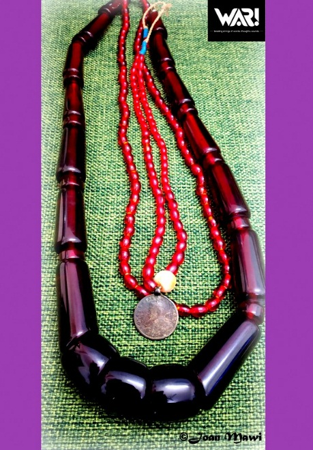
Photo: Some of grandma’s traditional necklaces with a coin in one of the necklace.
My grandma had one loin cloth which was weaved by her along with her sister which she kept safely inside the box. It was the Hmaram puan - A short lungi/loin cloth which was designed in black and white coloured patterns. The black threads were dyed from natural colours and mixed with white cotton threads which were weaved in a particular pattern. When I grew up, I asked grandma to give me but she refused to give it to me or to anyone else as it was her most treasured possession.
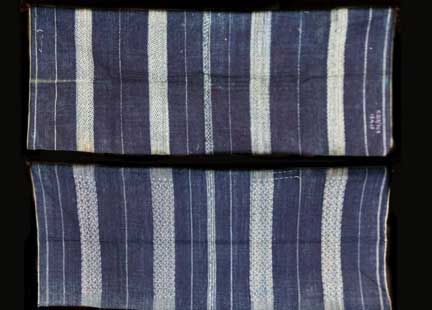
Photo: Hmaram puan (weaved from naturally dyed colours)
Source: https://mizoculture.mizoram.gov.in/post/mizo-puan-panga-5-in-gi-registration-a-nei-fel-ta
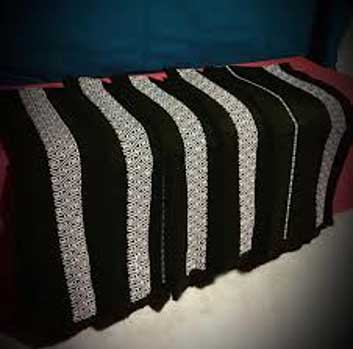
Photo: Hmaram puan (modern design and colours)
Source: Mizo online shop (Facebook page)
My grandpa had no particular precious item inside the pointed cover Thul basket, but there were some traditional Puandum (Shawls) which must have been weaved by my grandma.
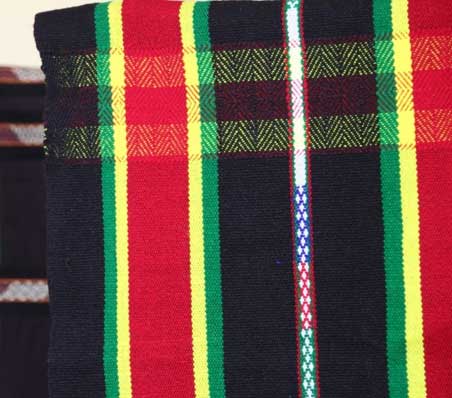
Photo: Puandum - Paite traditional shawl
Source: www.paite.org
It was the culture that women weave clothes and men would be more involved in doing traditional jhum cultivation or farming. Women also do work in the fields along with the men. My grandparents would narrate to us how they would spend the days during the various phases of their farming – clearing the farm sites by burning a portion of the hill - also called slash and burn, tilling the soil, sowing the seeds and harvesting. We would all listen with rapt attention as they tell us by the fireplace at night.
It is sad that today, there are very few who could make these kinds of basket. Basketry is a skill which is gradually dying in our regions. This particular craftsmanship needs certain hand skills and as such was not done as a profession in the past. I was being told by my grandpa that basketry was usually done by the men during their leisure times at night or non-agricultural season. He was a skilled craftsman who could make various baskets with bamboo and cane, bamboo fences for our vegetable garden at home, charpoys or cane stools, fruit and vegetable baskets, etc. in various designs. I love to observe how his skilled hands would go up and down the long thin cane strings and ropes, how they would be sewn around tightly and then they would turn into beautiful items. He told us that he acquired the skill from his parents and friends during his childhood based on observation and keenness to learn. He did not go through any formal training on basketry or cane making, but it is amazing how he mastered this skill himself and does it out of interest.
This kind of craftsmanship could be revived by training some of our unemployed youths. Beautiful and sleek designer chests or closets are available in the market, however, they cannot replace the beautiful ethnic design of these precious artefacts. Little do we realise that as these items and the craft are dying, it will soon be out of people’s memories as well. The younger generation have no association with these kinds of traditional artefacts. As a family, we treasure my grandparents thul, we are glad to have them still intact in our home and we hope to continue preserving them in future too.
============
References:
Shakespear, Lt. Col. J. 1912. The Lushei Kuki Clans, Mac Millan and Co. Ltd.
http://zoindigenous.blogspot.com/2010/01/bamboo-and-cane-culture-of-mizoram.html
Inputs received from an informant who is a Member of the Paite Cultural Society, Manipur.
Mrs. Joan Lalromawi can be reached at This email address is being protected from spambots. You need JavaScript enabled to view it.
